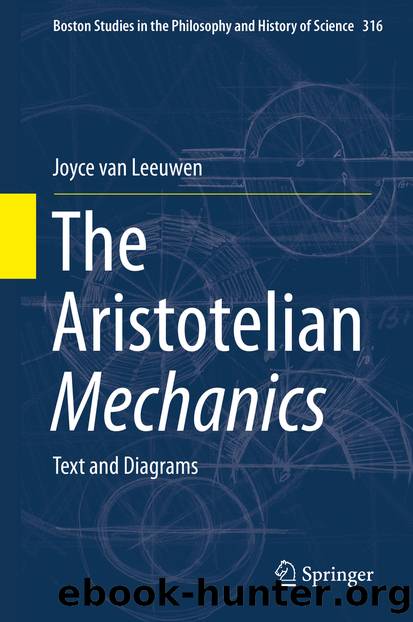The Aristotelian Mechanics by Joyce van Leeuwen

Author:Joyce van Leeuwen
Language: eng
Format: epub
Publisher: Springer International Publishing, Cham
4.2.2 The Lettered Diagram
The practice of applying letter labels in the text to refer to an accompanying diagram is associated particularly with Greek mathematics. The author of the Mechanics employs this technique in a number of the mechanical problems. In applying letter labels to mechanical objects, the author creates a relationship between the text and the diagram. In this section, we will see that text and diagram in the Mechanics are interdependent. The text cannot be considered a set of instructions on how to draw the diagram, but clearly presupposes the presence of a diagram and refers to specific relations in it. However, the diagram in itself is not sufficient to understand and reconstruct the authorʼs argument. Even though most diagrams are recoverable from the text, the text does not define one diagram specifically. A comparison between the manuscript diagrams and those in the modern critical editions reveals that different diagrams can be constructed on the basis of the text. This is mainly due to the fact that many letters in the description are not clearly specified.22 Let us take as an example the following description at lines 855b5-6: âFor let there be a larger circle ÎÎÎ, a smaller ÎÎÎ, and Î the centre of both.â23 The letter Î in this description is completely specified as the centre of both circles. The circles are, on the contrary, underspecified; we know the labels of the larger and smaller circle, but we do not know where these labels should be positioned on the circles. In the description that follows, these labels receive increased specification, and we can infer that Î and Î are placed at the top of both circles. Underspecified letters like ÎÎÎ and ÎÎÎ form the largest class of labels in the Mechanics. Often they receive complete specification in the course of an argument, but sometimes they remain underspecified.
This occurs, for example, in a description of motion in a circle in lines 849a2-3 of the text: âLet there be a circle, ÎÎÎ, and let the endpoint Î be moved to Î; it comes at some time to Î.â24 In this description, the circle is again underspecified, since we do not know where the labels Î, Î and Î are positioned on the circleʼs circumference. From the following description, we learn that points Î and Î are opposite one another, since line ÎÎ is further defined as a diameter of the circle. However, there are still numerous possible positions for these points, all in agreement with the text, and thus these points remain underspecified. In these lines, we find a label that is again of a different nature, namely Î. This letter is completely unspecified by the text; its position is unknown, whether on the circumference of the circle, or at some point inside or outside the circle. We only know the position of Î because we see it in the diagram. If we were to draw this diagram based on the description alone, we could not know how the diagram configured by the author would look.
Download
This site does not store any files on its server. We only index and link to content provided by other sites. Please contact the content providers to delete copyright contents if any and email us, we'll remove relevant links or contents immediately.
The Complete Stick Figure Physics Tutorials by Allen Sarah(7264)
Secrets of Antigravity Propulsion: Tesla, UFOs, and Classified Aerospace Technology by Ph.D. Paul A. Laviolette(5237)
Thing Explainer by Randall Munroe(3849)
The River of Consciousness by Oliver Sacks(3498)
The Order of Time by Carlo Rovelli(3096)
How To by Randall Munroe(2969)
A Brief History of Time by Stephen Hawking(2911)
I Live in the Future & Here's How It Works by Nick Bilton(2900)
The Great Unknown by Marcus du Sautoy(2612)
What If?: Serious Scientific Answers to Absurd Hypothetical Questions by Randall Munroe(2587)
Midnight in Chernobyl by Adam Higginbotham(2432)
Blockchain: Ultimate Step By Step Guide To Understanding Blockchain Technology, Bitcoin Creation, and the future of Money (Novice to Expert) by Keizer Söze(2409)
Networks: An Introduction by Newman Mark(2303)
The Meaning of it All by Richard Feynman(2268)
Easy Electronics by Charles Platt(2252)
The Tao of Physics by Fritjof Capra(2204)
Midnight in Chernobyl: The Untold Story of the World's Greatest Nuclear Disaster by Adam Higginbotham(2126)
When by Daniel H Pink(2057)
Introducing Relativity by Bruce Bassett(2048)
